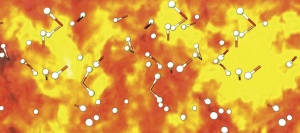Mar 20 2009
The most abundant material on Earth exhibits some unusual chemical properties when placed under extreme conditions.
 Simulations of the detonation of a high explosive show that 'extreme' water (molecules with one red hydrogen atom and two white oxygen atoms) can act as a chemical catalyst that promotes the transport of oxygen between reactive sites.
Simulations of the detonation of a high explosive show that 'extreme' water (molecules with one red hydrogen atom and two white oxygen atoms) can act as a chemical catalyst that promotes the transport of oxygen between reactive sites.
Lawrence Livermore National Laboratory scientists have shown that water, in hot dense environments, plays an unexpected role in catalyzing complex explosive reactions. A catalyst is a compound that speeds chemical reactions without being consumed. Platinum and enzymes are common catalysts. But water rarely, if ever, acts as a catalyst under ordinary conditions.
Detonations of high explosives made up of oxygen and hydrogen produce water at thousands of degrees Kelvin and up to 100,000 atmospheres of pressure, similar to conditions in the interiors of giant planets.
While the properties of pure water at high pressures and temperatures have been studied for years, this extreme water in a reactive environment has never been studied. Until now.
Using first-principle atomistic simulations of the detonation of the high explosive PETN (pentaerythritol tetranitrate), the team discovered that in water, when one hydrogen atom serves as a reducer and the hydroxide (OH) serves as an oxidizer, the atoms act as a dynamic team that transports oxygen between reaction centers.
“This was news to us,” said lead researcher Christine Wu. “This suggests that water also may catalyze reactions in other explosives and in planetary interiors.”
This finding is contrary to the current view that water is simply a stable detonation product.
“Under extreme conditions, water is chemically peculiar because of its frequent dissociations,” Wu said. “As you compress it to the conditions you'd find in the interior of a planet, the hydrogen of a water molecule starts to move around very fast.”
In the molecular dynamic simulations using the Lab's BlueGene L supercomputer, Wu and colleagues Larry Fried, Lin Yang, Nir Goldman and Sorin Bastea found that the hydrogen (H) and hydroxide (OH) atoms in water transport oxygen from nitrogen storage to carbon fuel under PETN detonation conditions (temperatures between 3,000 Kelvin and 4,200 Kelvin). Under both temperature conditions, this “extreme water” served both as an end product and as a key chemical catalyst.
For a molecular high explosive that is made up of carbon, nitrogen, oxygen and hydrogen, such as PETN, the three major gaseous products are water, carbon dioxide and molecular nitrogen.
But to date, the chemical processes leading to these stable compounds are not well understood.
The team found that nitrogen loses its oxygen mostly to hydrogen, not to carbon, even after the concentration of water reaches equilibrium. They also found that carbon atoms capture oxygen mostly from hydroxide, rather than directly from nitrogen monoxide (NO) or nitrogen dioxide (NO2). Meanwhile water disassociated and recombines with hydrogen and hydroxide frequently.
“The water that comes out is part of the energy release mechanism,” Wu said. “This catalytic mechanism is completely different from previously proposed decomposition mechanisms for PETN or similar explosives, in which water is just an end product. This new discovery could have implications for scientists studying the interiors of Uranus and Neptune where water is in an extreme form.”
The research appears in the premier issue (April 2009) of the new journal Nature Chemistry.